CES 2019 Question and Answer Session with AMD CEO, Dr. Lisa Su
by Ian Cutress & Gavin Bonshor on January 29, 2019 10:00 AM EST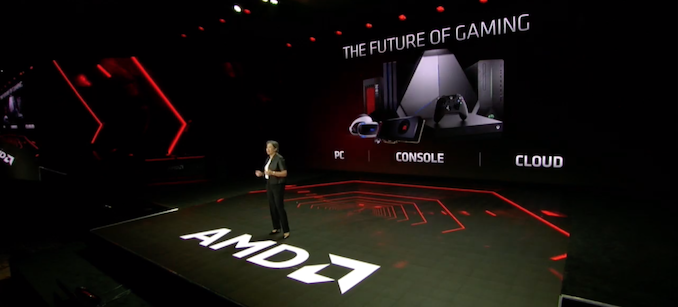
One of the major highlights of CES was the reveal of AMD’s next generation Matisse processor. With the cores built on TSMC’s 7nm process, the demonstration of the eight core processor showed performance parity with Intel’s latest eight core, 5 GHz consumer processor – all while consuming less power than the Intel part. AMD’s CEO, Dr. Lisa Su, was on stage to present both Matisse, due for launch in the middle of 2019, and the new line of Radeon VII graphics cards, also using TSMC’s 7nm. We caught up with Lisa for part of a roundtable Q&A session after the keynote presentation.
These roundtable Q&A sessions are relatively informal, however it must seem almost like a job interview to the interviewee. Dr. Su had a couple of team members on hand, but there were almost a dozen press at the event, including PCWorld, Engadget, PCGamesHardware, Digital Trends, CNBC (I think?), and of course, AnandTech. Rather than take turns, questions were freeflowing from all directions and jumped around a lot. For the sake of sanity, we have rearranged the questions into topics, as well as tidied up some of the questions and answers to make them readable (it turns out, people don’t speak in normal sentences).
Many thanks to Dr. Su and her team for their time.
Also a big thanks to Gavin Bonshor for his excellent transcription.
The AnandTech Questions
Ian Cutress: Last year you gave a presentation where you kind of laid out the major product announcements for the first half of 2018, and then teased us about the products in the second half of 2018. This year was less specific, with just a broader split of ‘GPU now, CPU later’. Is that a change in strategy?
Lisa Su: What we want to do is make sure that the consumers have a good idea of when to expect these products. So with Radeon 7, very quickly you'll see it on shelf in February. I think the next big thing is our 3rd Generation Ryzen. I know there's a lot of anticipation about that. You know the key point is the part looks good. The part looks really good, and we'll put it out sometime in the middle of the year. We haven't decided the exact month yet, there's a little bit more tuning to be done. We want to get the clocks in the right place, we want to get all of the performance in the right place but it looks good. You'll see it in the middle of the year, similarly the next generation EPYC is very much in development and we think things look really good there. You see us all the time Ian, you'll get more information soon (laughs) !
IC: On the separating everything into chiplets question, how does AMD solve a chiplet approach to graphics? Given that the next generation of EPYC is eight chiplets of eight cores each, but the graphics side is still monolithic. Splitting up GPUs into multiple dies is a tough problem to solve - would it necessarily require a paradigm shift in the way that graphics hardware is approached?
LS: I think we continue to look at every generation in terms of what's the right with respect to partitioning. So whether it is splitting the GPU, or as people have asked us before ‘Might you do a CPU die and a GPU die?’ - those types of things. I think [we will do] what makes sense. You really have to look at what the interconnect is too - we have our Infinity Fabric that Mark has talked to you guys about and you know how that performs relative to the various other pieces.
Q: Before the keynote, I had some of my writers pinging me about they were speculating about the number of cores on Ryzen.
LS: It only took like 20-30 minutes for somebody to ask that!
Q: AMD was showing quoted an 8 core 16 thread set, is that generally an indication of where Ryzen 3rd gen is going to be at?
LS: If you look at the evolution of Ryzen, we've always had an advantage in core count and so in this particular case we wanted to show sort of a head-to-head comparison of eight cores and sixteen threads [against the same]. Some people may have noticed on the package that there's some extra room...
IC: We've already done the calculations!
LS: Have you already done it? has somebody done that? Ok, alright, so there is some extra room on that package and I think you might expect that we will have more than 8 cores. I didn't say how many more...I said more.
IC: And will two memory channels will be enough?
LS: As I said, more [information] to come (laughs)!
IC: You're now introducing chiplets – how [is that approach] affecting the semi-custom business? Is there now more interest given that you now have this technology on a large scale and people are interested in deploying it in what they're doing?
LS: We believe that it will accelerate the semi-custom breadth of opportunity, and the idea that you could use our CPU and then use our sort of memory, our fabric and a custom ASIC. So yes, that's part of the conversations that we're having around semi-custom.
IC: So question here, is AMD going after the single threaded performance crown? Is that a key target with next generation products?
LS: Our first priority is overall system performance, but we know how important single threaded performance is and so you will us push single threaded performance. And I'm not making any predictions.
IC: AMD's financials have looked really good as Ryzen has ramped, and 2nd generation products have come through. How has that extra influx of money been beneficial to you in terms of R&D? Can you point to specific examples of projects you might have not been able to do if Ryzen hadn't performed as well as expected?
LS: Well I think what you'll see is we are pretty deliberate in how we roll things out. With our Ryzen and EPYC and Radeon, the thought process is to do things in steps. So the conversation about “hey, Vega wasn't supposed to be in 7nm for gamers” - actually, that was not really true, as we were going to do it in steps. [It is] the same thing in terms of how we're bring 7nm technology to market.
We are spending a lot more time on software and a lot more time with software developers to optimize on AMD. I think that's really critical. I think we are doubling and tripling down on graphics, and that's one of the reasons we talked so much about gaming today. But we are thinking about graphics in the broad sense of graphics, and so it's PC gaming, but it's also everything else that goes along with, including cloud gaming, including consoles. We think once you put that entire ecosystem together, Radeon's going to be the most powerful gaming brand out there.
IC: So with TSMC making all the chiplets, and you've still got GlobalFoundries doing the IO die, how is that effecting the wafer supply agreement with GlobalFoundries as the proportion of your products change over to TSMC?
LS: What we've said is that GlobalFoundries is a good partner, [and] they've done a good job for us with 14nm, [and] we really appreciate their partnership. You know we're working on how to amend the wafer supply agreement such that it covers the change in strategy that they have in place. We'll be talking more about more about that shortly.
IC: How's Navi?
LS: Doing well, I said Navi today didn't I?
IC: You mentioned Navi and Zen 5!
LS: (laughs) You'll hear more about Navi. Navi is doing okay
IC: Will we hear more in this year about that?
LS: Yes, you will hear more about Navi in 2019. It is [going to be] a very active graphics cycle for us.
Other Questions: NVIDIA and Ray Tracing
Q: Jensen has had some things to say about the Radeon 7. According to Gordon (from PCWorld), Jensen says the Radeon 7 is “underwhelming, and the RTX 2080 will crush it”. There's a fuller quote that says "the performance is lousy and there's nothing new; there is no ray tracing, no AI, it's 7nm with HBM memory that barely keeps up with the 2080 and if we turn on DLSS, it'll crush it. And if we turn on ray tracing, it'll crush it”. Anything to say on that?
LS: We are very excited about Radeon 7. Now I would probably suggest he hasn't seen it yet. There are 400 million gamers that are using Radeon, so we have a pretty big base. When you look at that, much of the conversation you guys have asked me time and time again is “What's the next high-end GPU from AMD?” My view of it is we had to bring Radeon 7 to market - it’s important for our fan base and for high end gamers. We think it performs very very well. If you look beyond, if you look at the memory technology and what we have, I think we feel good about it and I think you guys will see soon enough for yourself.
Q: How are you seeing the performance on it compared to something like the 2080? I think he [Jensen] was comparing it to the 2080, just a straight 2080. I presume that you guys have seen some of the cards there. But what is the performance looking like? Except the ray tracing stuff?
LS: We showed some data [at the keynote], and I some of the data is in our press release. I think what you'll see is [that we are] very comparable in games. We win some, we lose some. But the key about the 2080 is yes, there's a lot of feature function, and ray tracing is important, [but the] Radeon 7 also does a lot of things across the content creation workloads, you saw some of our OpenCL numbers that we're really really phenomenal and we think that it's very competitive.
Q: Can you give us a sense of what AMD is thinking about ray tracing or any future technologies? From my end, we're seeing the FPS wars go on and on, but it seems like at that point it doesn't matter in visual quality. In games, ray tracing could be bigger leap for some gamers. Where is AMD at this point in that?
LS: We spent a lot of time today talking about our vision on gaming. Our vision on gaming is very broad and we think about it across PCs, consoles, the cloud, and how we deliver content to all those places. I think ray tracing is an important technology, it's something that we're working on as well from both the hardware and software standpoint. I think the important thing though, and that's why we talk so much about the development community, is [that] technology for technologies sake is ok, [but] technology done together with partners and really getting the development community fully engaged I think is really important. You're going to see a lot more gaming discussion from us as we go through this year and into the future. We view it as a broad ecosystem, we don't focus on just taking one technology, but you need all of this stuff to really come together.
Q: NVIDIA has ray tracing, what has AMD?
LS: I'm not going to get into it tit for tat, that's just not my style so I'll tell you that. What I will say is [that] ray tracing is an important technology – it is one of [a number of] important technologies. There are lots of other important technologies you will hear more about, [as well as] what we're doing with ray tracing. We certainly have a lot going on both hardware and software as we bring up that entire ecosystem.
Q: I think it's fair to say that there has been some criticism of NVIDIA's approach because they've had the hardware support and a lot of software support to it. But with that, would it be fair to say that you are trying to reach more to bring it out while and to enable more of a unified ecosystem?
LS: I would say that we are deep in development, and that development is concurrent between hardware and software. That's the key, so what is the consumer going to see? The consumer doesn't see a lot of benefits today because the other parts of the ecosystem are not ready. I think [that] by the time that we talk more about ray tracing, the consumer is going to see the benefit.
Q: Do you guys have a time frame for when we could see that stuff? 2020 next generation consoles?
Robert Hallock, AMD: We have a time frame but not something we’re disclosing at this time.
Other Questions: Intel
Q: Intel has talked about Lakefield, where they are stacking the dies. I was wondering if you guys had any thoughts on that approach and whether it made sense for AMD as well?
LS: I think this whole notion of breaking the chips up is sort of the wave of the future. So, we did it first with HBM on the graphics side and then with these chiplets that we're using here on the EPYC and Ryzen side. I think chip stacking will continue to be important going forward and we will look at it as there's different ways to put these architectures together but I think the foundation is something we believe very much in.
Q [Intel is] not only doing that, but they are taking that ‘big.Little’ approach where they have got a big core and the four atom processor cores on top of that too. You guys don't really have an Atom compliment to Ryzen, but I mean could you possibly work with Arm or some other architecture or is that not possible?
LS: I would say [that] anything might be possible, [but] the question is, ‘is it necessary?’ I think what we've done with Zen is build something that actually is pretty scalable. I mean if you think about it, we scale Zen from notebook form factor all the way up to the server form factor, and we do pretty well. So, I think the idea of putting different chips together, IO, memory, and do you partition that, and how you look across all of the different form factors is important. That's something that our team feels really passionate about.
Q: Last year, one of the interesting announcements was AMD graphics on the Intel chip (Kaby Lake G). Can you talk about how that partnership went over the last year? We didn't see too many notebooks taking advantage of that. I saw a handful but not that many - is that relationship going to continue this year?
LS: It was an opportunity for us to get Radeon into more applications. It is part of our ‘Radeon Everywhere’ message, and it appeared in some notebooks and those were pretty high-end premium notebooks that really wanted the form factor. It was really a form factor thing in terms of the power. We'll see how that goes, we don't have anything more to say about it at this point in time, but we'll see how that goes.
Other Questions: Monitors
Q: NVIDIA [has] opened itself to FreeSync. Can we expect any reaction from AMD to that or what do you think about it?
LS: We knew FreeSync was the right answer, [and] we've known FreeSync is the right answer for a couple of years. The fact that others have decided FreeSync is now a good answer. I think says that we made the right choice a few years ago.
Q: You're just [only] happy about it? That they're going to use your technology?
LS: (deadpan) I'm not unhappy about it (!). (laughs)
We believe in open standards, and we believe in an open ecosystem. That's been our mantra, so we have no issue with our competitors adopting FreeSync. We think that it's better for gamers and we did a good job.
Q: NVIDIA pointed out that a lot of FreeSync monitors [in the market] today, [and] their quality is all over the place in terms of brightness, color gamut, and things they support. Is AMD going to be working with monitor manufacturers to focus on that quality a little more? Because it seems like there is a huge variety right now.
LS: Well if you really think about it, what problem are you trying to solve? The way we look at it is there are a whole host of monitors and TVs out there, over 550 [of them], at very different price points. So [we have] entry level versus super-duper premium gaming monitors. We certify and we make sure that they work with FreeSync, and you will get the experience that you pay for on the monitors. So I don't actually see a problem frankly...
Q: Apparently Jensen believes that FreeSync doesn't work. He said that today, amd he said that they found that they weren't working on a regular basis.
LS: I don't believe we've seen that to be the case so (laughs)
Robert Hallock, AMD: One other thing I'll say is that the FreeSync 2 standard is much more stringent. The quality demanded of the monitor in terms of backlight nits, backlight deltas, from dimness to brightness as the refresh rate changes, the color gamut requirements for HDR, requiring coverage with the refresh rate range of the display. These are all things that we are taking a certification approach to ensure that minimum quality is provided.
Q: Do you think it’s fair to characterize the use of [the terms] ‘FreeSync’ and ‘Adaptive Sync’ interchangeably? I can see that a lot from some competitors.
LS: I think it's a good point. I do think there use a little a bit interchangeably and I think that is ok. So, it's all basically adaptive sync technology, [but] FreeSync is the free version. There are adaptive sync technologies but that's what I would think about it. Is that right Robert?
RH: The other thing I'll add is that the DisplayPort adaptive sync standard makes no qualitative recommendations on the experience. A range of only 2 Hz is sufficient for the DisplayPort adaptive sync standard. Obviously we have much higher standards for gaming that help with color, backlight flicker, backlight bleed - you know all the things that gamers care about. That is something we uniquely bring to the table with our certification program versus just ‘yep, it's adaptive’. So that is where the difference lies, it's in the qualitative.
Q: We saw NVIDIA working with HP to release this gigantic gaming monitor this year. Are you guys having a similar partnership with Samsung? I think it's Samsung, can you speak at all to that?
LS: We have really good gaming partnerships, some monitor partnerships with a bunch of folks. Samsung is one, but [there are] a few others as well. So, you'll see some larger monitors from us this year.
Q: Is there any concern [about DisplayPort]? When I spoke with Samsung, they seemed reluctant to put DisplayPort into a TV. But at the same time, I think with FreeSync, you do really start to see the benefits of with DisplayPort. Is that like a conversation with them? Is it just up to them?
RH: HDMI supports FreeSync now and HDMI even has its own sub-spec. We don't know if they're going to do HDMI 2.1.
Q: I saw that Dell just announced a 55" OLED 4K with DisplayPort. [It] looks really cool, did you guys notice that? It looks amazing, do we know if that is FreeSync certified yet or anything? It does have adaptive sync but....
LS: I don't know. We should check though.
Other Questions: Laptops
Q: How is the relationship working with a lot of these laptop manufacturers? I see them putting out AMD products but their flagships [and] their big splashy ones continue to be Intel. How is that working, are you pushing on them?
LS: You know, it's a journey, but we're making progress. My commentary to the OEMs is [that] we care about PCs and we are investing in PCs. We are investing on both the desktop and the notebook form factor. I would say that the first-generation Ryzen notebooks were good - some of them are very good. I think the second-generation Ryzen notebooks are going to be a lot better and [in] a broader set of form factors.
One of the things I get to do when I come to this show is that they show me some of the new form factors. So I was meeting with one OEM yesterday and they were going to triple their designs with AMD. That's really cool - I'm happy with that! Some of them are really really nice, so I'm looking forward to those coming out as we go through this year. But it's a journey. and from my standpoint we've made good progress. We gained notebook share in the 4th quarter as we really started ramping, and I think second gen Ryzen is better than first. Third generation mobile is going to be better than second.
Q: Do you think there's anything more you guys could do to shift that conversation? I think that even in the public’s eye, AMD is still for their bottom line. [While it’s] not necessarily true, but I think that's the perception.
LS: I think it's a familiarity. So what's really interesting is [if] you look at the different markets, in the desktop enthusiast market where the people who read your columns who are really savvy on technology, they love Ryzen. I mean actually truth be told, I watch our rankings very closely on the top e-tail websites. If you were to go on Amazon.com, for the last while I think we've been number one.
Q: It helps that you have some in stock! (Lots of laughs)
LS: It helps that it's a great product at a good price and in stock. That adoption has gone really well because folks are really savvy and they’re looking at the specs and they can see the value. Sometimes on the notebook side, because you go through so many different people, [such as] you go from the OEM to the retail buyer, to the retailer, to the blue shirt in Best Buy that has to explain to the guy at home who doesn't know much about chips. There are a lot of people to explain that message to and that's part of our job. Part of our job is to get more people familiar with what AMD can bring to the party and we believe we're making good progress. But it doesn't happen overnight and so yes, we have work to do but we're making good progress.
One of the key value propositions for Ryzen Mobile, and if you look at some of the systems like the Acer Nitro 5, [is that they are] casual entry level gaming systems. We have a couple more that are in development that will be launched this year with the second generation Ryzen, so we should have some systems for review, and it is one of the nice differentiating features of second generation Ryzen.
Q: I've noticed that when it comes to new PC manufacturers, we're seeing a lot of new things coming. Microsoft has worked closely with Intel on the Surface, [and with] a lot of other companies have to. Is AMD working as closely with the manufacturers when it comes to designing these things and building a system around the processor?
LS: Much more so now. When we were catching up a bit in performance and the chassis was already available, [we would] figure out how to slot the AMD processors in it. Now as we look at our roadmaps, we have some interesting things coming, sort of beyond what we've talked about today, but beyond second generation Ryzen. We are starting to work much more closely with a couple of folks to define that form factor.
Q: I feel like we've seen kind of a race to the smallest Z height in a lot of laptops and tablets in the last couple of years, especially with [devices like] the 7mm Google Pixel Slate with its Intel [CPU inside]. Are you guys at all concerned about that race, [and] do you think that there is merit in smaller Z height?
LS: I think there's a lot of merit to the fact that people like sleeker form factors. [Users] like to carry something that's lighter – it just has a cooler feel to it. But [users want it] not at the expense of performance. So our focus has always been, yes, we need to do that and yes that means we might do things differently in packaging and yes, we got to focus on power and power efficiency. But it's got to have minimal performance loss because we're not trying to be a tablet – we are trying to be really the productivity engine of the devices.
Other Questions
Q: I'm curious where we are in the story of Vega right now because when Vega first came out [it] very exciting. [We] didn't hear a lot about Vega after that, and it kind of faded out from the conversation a little bit. And now BAM, [it’s] back. But how is AMD going to keep it there?
LS: Well I think the way you should look at it is broadly across the market. So, Vega actually has done really well for us. I mean you see it in a bunch of different places. We saw it in the discrete graphics cards that we talked about, [such as] Vega 64 and Vega 56. You saw it in some workstations, certainly coming from Apple. You have seen it in smaller form factors as well. So the Vega architecture is in our notebook graphics and is in the work that we do there. We showed the Google Project Stream that's using Radeon Pro Vega. We have other cloud environments that we've used Vega.
As architectures go, they get better with time. It's like that whole idea of more developers and software optimizations, and Vega has definitely gotten better with time. I think Vega on 7nm, we launched it in the 4th quarter for data center applications and in that form it's MI60 and MI50 and that's going into HPC markets. That's going into cloud, that's going into machine learning opportunities, that's going into virtualization opportunities, so that's a really important segment for Vega. And then today we talked about our Radeon VII for gamers. I think that there's a broad view of the ecosystem [with Vega].
Q: The 7nm Vega was not supposed to be a consumer graphics card?
LS: Well you guys said that, I never said that! (laughs)
Q: It wasn't consumer in 2018.
LS: What we said was we would do data center first, I think that's what we said (clarified by someone else). We didn't say anything else after that, actually if I remember correctly. What I said at Computex in June was that you will see 7nm gaming parts from us. We always planned to bring Radeon 7 to the market - that was always in the plan. Our goal is that we want to delight our fans and so we wanted time to get the software optimizations ready and we did quite a bit of that. With every new architecture there are things we want to do better. We wanted to do the work we did with Ubisoft and Capcom on those optimizations and then bring it out when it's ready. And gaming also is a high-volume market and so we wanted the technology to mature a little bit as well.
Q: So any comments on Threadripper?
LS: Content creators are important to us and Threadripper has done really well. Actually, I've been pretty pleased at how second generation Threadripper has done because you think about it as a pretty niche type of market, but there are people who want more performance. So as second generation Threadripper has come into the market, frankly it just looks like more people have adopted [it]. I think the thing about us keeping our infrastructure consistent is important and we'll talk more about Threadripper as we go through 2019.
Q: Is there anything else you can say about the specifics of the 7nm architecture? It was mentioned having more performance while using the same amount of power draw, but will it make for better overclocking?
LS: Well I think you see a couple of different things and it manifests itself in a few different ways depending on which market you're looking at. Like for example when we talk about the server market, 7nm just gives you an incredible amount of density and so you can double the number of cores. You get four times the floating point [performance] and there it’s more from sort of the data scientist standpoint. You're just going to be able to run your simulations much much faster and get more done.
When you go to the desktop, today we showed the preview of the third generation Ryzen and you could see one of the things that we we're trying to show is that you can get very similar performance, maybe slightly better (but whatever, similar performance) at about 30% less power. What that means [is] you can take the less power if you want it, and that's useful if you're doing small form factor PCs, or you can up the frequency and get more performance. We look at those tradeoffs and yeah, we'll continue to look at those tradeoffs.
Q: [For] the 7nm process node from a supply standpoint, from a manufacturing standpoint, is [it] proceeding normally [with] no problems?
LS: We're quite happy with how things are going. We now have a number of different products that are going through 7nm and I would say things look good.
LS: Thank you guys for attending the keynote! I'm going to tell everyone that we broke Ian's website! (lots of laughs, as our AMD Keynote live blog had issues because of traffic volume)
Related Reading
- AMD CES 2019 Keynote Live Blog
- AMD Ryzen 3rd Gen 'Matisse' Coming Mid 2019: Eight Core Zen 2 with PCIe 4.0 on Desktop
- AMD: “No Chiplet APU Variant on Matisse, CPU TDP Range same as Ryzen-2000”
- AMD Reveals Radeon VII: High-End 7nm Vega Video Card Arrives February 7th for $699
- Getting Radeon Vega Everywhere: An Interview at AMD Tech Day, with CEO Dr. Lisa Su
- Making AMD Tick: A Very Zen Interview with Dr. Lisa Su, CEO


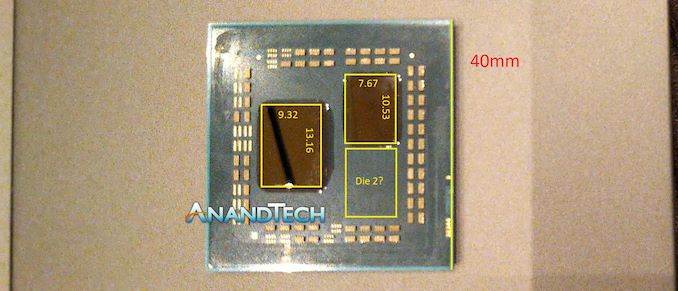
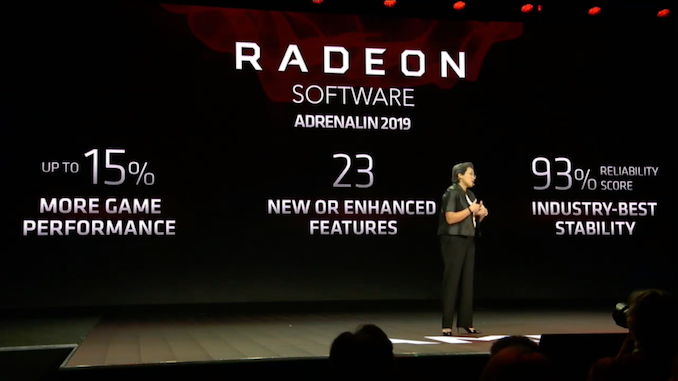

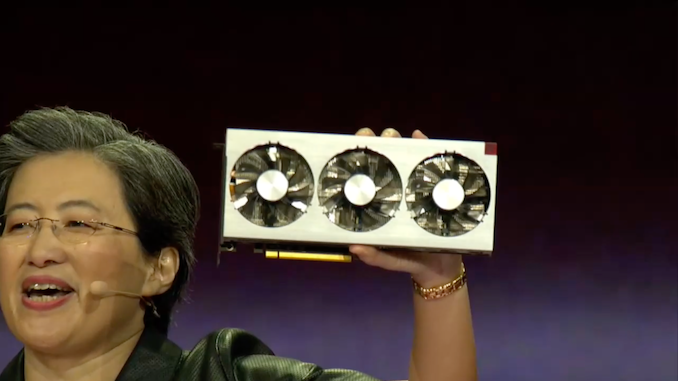
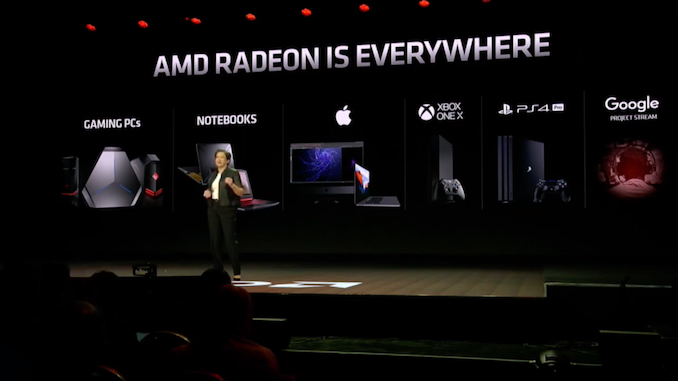
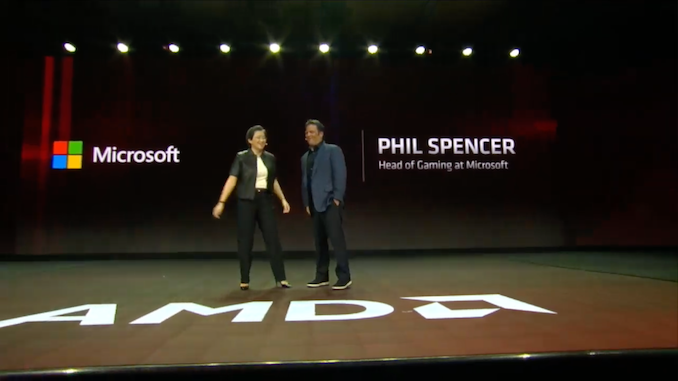
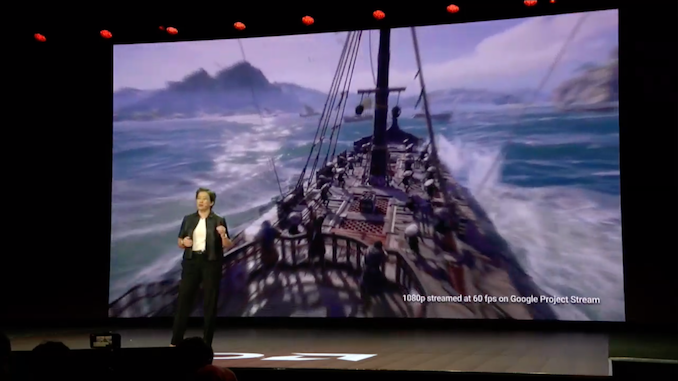
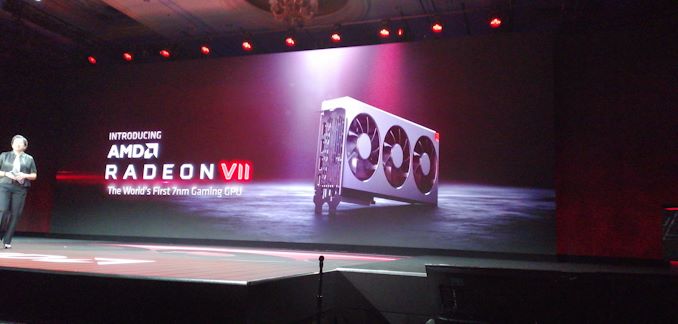








60 Comments
View All Comments
0ldman79 - Tuesday, January 29, 2019 - link
"You guys don't really have an Atom compliment to Ryzen"Has he forgotten about Jaguar? Y'know, the CPU in the consoles and a pretty large percentage of the laptops on the market...
jaju123 - Tuesday, January 29, 2019 - link
I think he was referring to a jaguar-style follow-up. Jaguar is beyond slow by this point.levizx - Wednesday, January 30, 2019 - link
It's not that slow, the point is to save power with light tasks, a Puma+ quad-core module on 12nm running at 2.4GHz alone would be more than adequate.But sure, if they were to do it, they would need to match Zen's instruction set (AVX2) in order for it to work and along with those redesigns we would expect IPC growth.
If they could incorporate a quad-core "Puma++" and 192SP Vega into the I/O die, coupled with a CPU and a GPU chiplets on the package, they could potentially make a very efficient SoC
0ldman79 - Thursday, January 31, 2019 - link
Gotta wonder if the PS4/XB1 have AVX2.Jaguar was a decent CPU. My wife's quad core, Beema I think it is, is pretty damn close to the first gen Phenom x4.
That's not monstrous, but it's a 15w chip that rarely hits 15w and matches the performance of a previous generation's 95w chip. It does have a few limitations that prevent it from really doing well, but in pure number crunching it's decent. It'll play Crysis, even with the integrated video.
It's funny how it's a useless, horrible, slow CPU but it's still in the consoles today. Admittedly their CPU load on the games lowers some details vs the PC, but still...
IGTrading - Thursday, January 31, 2019 - link
I don't think that Intel has any Atom that can beat an AMD Jaguar for the same form-factor and the same price while showing at least the same iGPU performance.sing_electric - Tuesday, January 29, 2019 - link
That's not a "Ryzen part" - it's a Dozer-era CPU with all the baggage that brings. The question was actually a pretty good one - Intel's decided to create a big.LITTLE-style x86 chip, which has some interesting applications where x86 wouldn't have necessarily been on people's first thought.When you look at Intel's 10nm process, it's actually a great idea - there's high density libraries that allow for very low power usage in minimal space, and lower density libraries that allow for higher performance, and this architecture lets Intel mix them.
And Su's answer was also interesting - it seems like its not really a focus at the moment, though she hedged her bets significantly.
Byte - Wednesday, January 30, 2019 - link
big.LITTLE had a hard road, and still isn't as effective as in theory. Nvidia failed hard with it, Samsung has stuck to it and has it working only decently in their phones. Apple is also working hard on it and getting close, their first iteration was not very good for battery life. Bottom line is that it doesn't bring as much power savings in theory and brings lots of complexities. On phones, always on devices, it makes sense. On desktops, almost no sense, laptops maybe. We are already seeing normal ultrabooks with 12+ hour battery life. I think this is enough for just about anyone compared to the old days of 4-6 hours. The LG Grams can hit 14 hours watching netflix at under 2 and a half lbs!!! As you can see AMD doesn't feel we need big little, and I agree. We need more speed!piroroadkill - Wednesday, January 30, 2019 - link
Actually, Jaguar has nothing to do with Bulldozer.Oxford Guy - Thursday, January 31, 2019 - link
As far as I recall, Jaguar has worse IPC than Piledriver.levizx - Wednesday, January 30, 2019 - link
What baggage? Jaguar/Puma (Family 16h) cores are very much traditional OOO CPU cores, very similar to Silvermont from Intel.